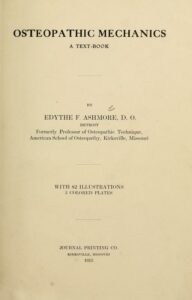Osteopathic Mechanics – A Text Book by Edythe Florence Ashmore
A volume made especially for students, featuring photographs and drawings to illustrate the osteopathic lesions and the most simple techniques to correct them. In 1914, Dr Ashmore was a lecturer at the American School of Osteopathy (ASO) of Kirksville.

Publisher: Journal Printing Co., Kirksville, Missouri (USA)
Year of publication: 1915
Number of pages: 237
The book is intended as a practical and clear tool, destined to the students of osteopathy. The volume presents 82 illustrations, 3 color tables and an analytical index. It is divided into 11 chapters:
- The lesion
- The normal movement of the spine
- Lateral curvature of the spine
- Flexion and extension lesions
- Rotations and sidebending lesions
- Cervical lesions
- Sacro-iliac lesions
- Rib lesions
- Occipito-atlantal lesions
- Clavicular and other lesions
- Soft tissue technique
The first chapter contains the definition of lesion and of subluxation, a brief description of the vertebral articulation and an explanation of what osteopathic diagnosis and technique are. In the second chapter the normal movements of the spine are described.
The following chapters focus on specific lesions: the description of each lesion followed by a paragraph on the methods of palpation and another paragraph on the movements used to correct lesions, often accompanied by illustrative figures and photographs, and a comment on the “post-treatment”.
In the “general rules”, reported at pag. 72, the author describes the two main methods employed by osteopaths: the oldest one is the method of traction while the most recent one is the direct method, or thrust. Dr Ashmore affirms that the method of traction is the most difficult to teach, therefore her preference goes to the thrust technique, which she finds useful to describe as “direct method” instead of using the actual term “thrust” for the aggressive connotation assumed by this word because of the imitators of osteopathy.
The seven pages of the last chapter deal with the treatment of soft tissues, emphasizing that this type of osteopathic treatment is very different from the massage techniques. The author states that, although it cannot replace the osteopathic “tuning” based on the normalization of the musculoskeletal system, soft tissue techniques can be useful and require specific training. By way of example, some maneuvers for the liver, eyes and intestines are described.
Strengths: the book, of considerable historical interest, is very clear and well-structured, every lesion is clearly described. The author declares in the preface to have always selected the most simple corrective movements, which could clearly illustrate the fundamental principles of the osteopathic treatment.
Weaknesses: as declared by the author of the preface, the book suffers from some terminological inhomogeneities.

Are you an osteopath?
Register and enjoy the membership benefits. Create your public profile and publish your studies. It's free!
Register now
School or training institution?
Register and enjoy the membership benefits. Create your public profile and publish your studies. It's free!
Register now
Do you want to become an osteopath? Are you a student?
Register and enjoy the membership benefits. Create your public profile and publish your studies. It's free!
Register nowHistorical osteopathy books
Osteopathy Research and Practice by Andrew Taylor Still
The fourth book of A.T. Still, written at the age of 82 years, enunciates the principles and the practical maneuvers of osteopathy in reference to the single pathologies, classified by body regions.
ReadHistory of Osteopathy and Twentieth-Century Medical Practice by Emmons Rutledge Booth
A milestone in the history of osteopathy. Emmons Rutledge Booth, who enrolled at the ASO in Kirksville in 1898 and graduated in 1900, met A.T. Still personally.
ReadPhilosophy of Osteopathy by Andrew Taylor Still
The second book published by A.T. Still, it collects the basic principles of osteopathy, written over several years and then gathered in one volume. Despite the insistence of his friends, Still was not sure that the time was ripe to divulge his early science.
ReadAutobiography of Andrew Taylor Still with a History of the Discovery and Development of the Science of Osteopathy by A. T. Still
A fundamental text to begin to know the founder of osteopathy and to understand the cultural context and the historical events during which his life unfolded.
ReadPrimitive Physick: or, an Easy and Natural Method of Curing most Diseases by John Wesley
A fundamental text for the Methodists, which Still’s father surely knew and probably owned - in addition to remedies, the book contains a preface that dispenses advice for a healthy life.
ReadThe Old Doctor by Leon Elwin Page
A small volume dedicated to the story of Andrew Taylor Still, and to the birth and development of the idea of osteopathy.
ReadThe Cure of Disease by Osteopathy, Hydropathy and Hygiene A Book for the People by Ferdinand L. Matthay
A small volume addressed to the general public, dispensing health advice and illustrating some osteopathic techniques.
ReadOsteopathy; the New Science by William Livingston Harlan
The volume collects and comments a series of relevant articles on the new science of osteopathy, highlighting legal, historical and theoretical aspects.
ReadA Manual of Osteopathy – with the Application of Physical Culture, Baths and Diet by Eduard W Goetz
Very schematic volume, with the aim of spreading the osteopathic application techniques to everybody, even to those lacking any sort of health training.
Read







